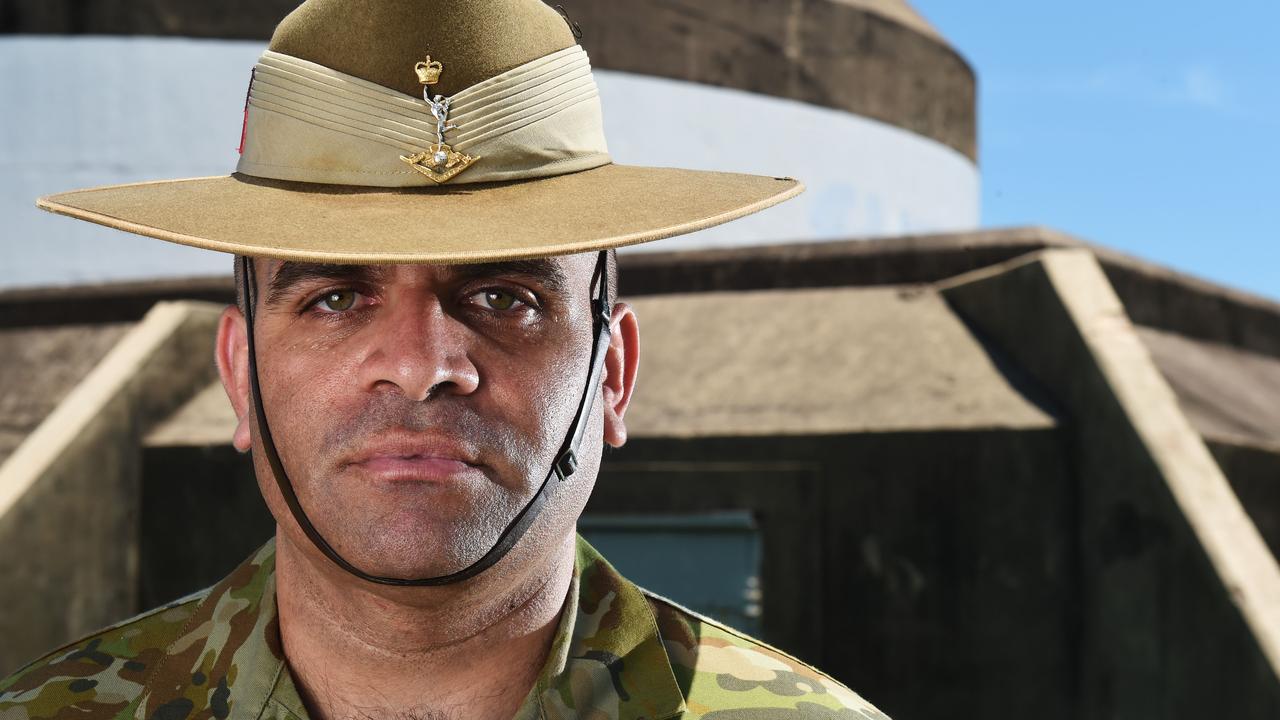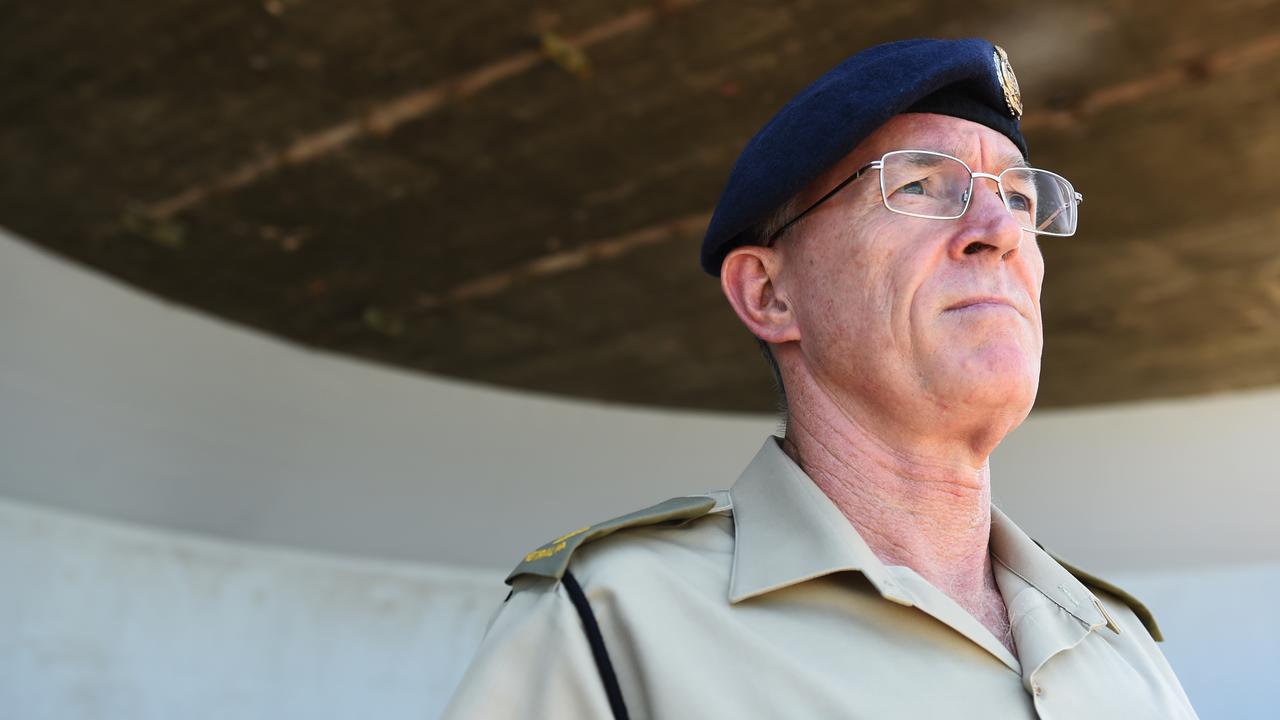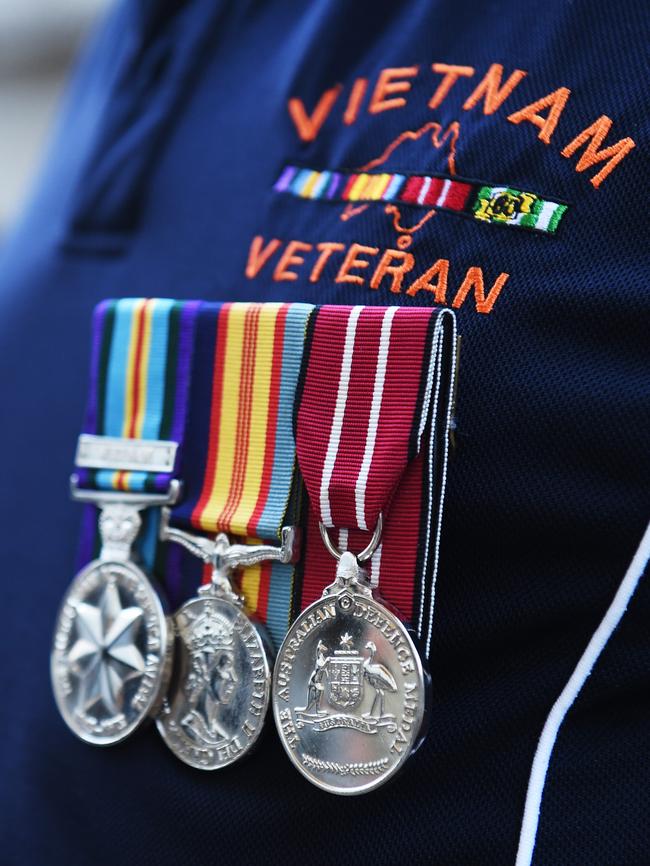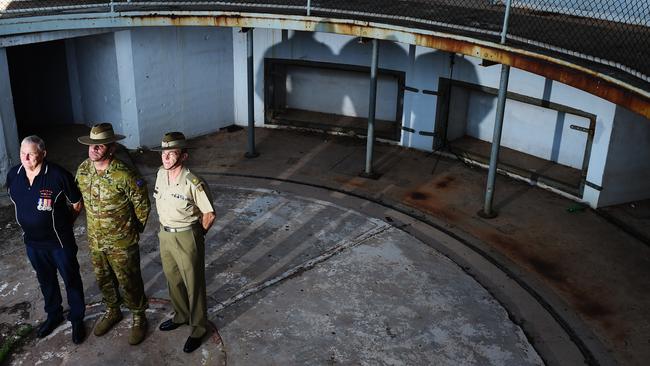Three diggers, two serving and one retired, meet to discuss the Territory’s important role in World War II — and how little Australia still knows about it
In a red, leather-bound album, grainy old photos of shirtless diggers in khaki shorts and boots lie perfectly attached to the page. Their socks sit just a bit higher than their boots, their slouch hats famously angled across their faces, keeping the hot Darwin sun from their eyes.
They are grinning, despite being in the middle of a war. They are young, despite being only alive in a photo album. They are a part of the Northern Territory’s history not well known to the rest of Australia — but their story will be told this year, for the 75th anniversary of the Bombing of Darwin.
This red leather album belongs to Vietnam veteran and long-time Territorian Bob Shewring. He carries it proudly and shows it to anyone who wants to learn a special piece of Darwin’s history. He’s particularly proud because it contains photographs of his dad.
Bob could tell you anything about the gun turrets at East Point Reserve. Built by his father, Bob gives in-depth guided tours about them — albeit unofficially. Pointing out where the ammunition was kept, how often the guns were used, how they were built, manned and what their role was in the protection of the Territory during a time of uncertainty, Bob could talk for hours — and on a day of reflection with currently serving diggers, he almost manages to do so.

Major Simon Harvey and Corporal Owen Brady are taken by Bob’s knowledge.Despite serving in Darwin, they don’t know the ins and outs of the turrets, so soak up Bob’s story like a sponge; asking questions like eager children on an excursion.
Major Harvey and Corporal Brady are a stark contrast to the men in those photos, and they joke about workplace health and safety 75 years ago, compared to now.
Their heavy, official uniforms, boots and hats don’t compare to the shorts and socks of past diggers. But all the same, they wear them with pride, having both served overseas and now here, and all calling Darwin home.
Corporal Brady, an indigenous member of the Australian Defence Force, remembers running around as an eight-year-old boy dreaming of one day joining the army.
It was kept as a secret from his family, who would have preferred to see him take on a sporting career over anything in the defence force.
“I had to tell my dad I always wanted to play football. If they knew when I was that young that I wanted to be in the army, they wouldn’t have let me,” he said.
“I was a little tacker in primary school, watching the ads on television, the action movies and I knew I wanted to be an army man when I grew up.
“All through high school I still kept it on the low down, playing sport and keeping dad from knowing I was gearing up to put on the green skin. I realised what I needed to get to enlist academically, and when those years came, I put in a little bit more to tick the boxes. I joined a bit later, at 23, and haven’t really looked back.”

You hear all these little stories about these war heroes but they don’t tell it in school enough. — Corporal Owen Brady
Having served twice in Afghanistan, a small stint in Iraq and plenty of jungle training overseas, Cpl Brady fell in love with the romance of the adventure of army life.
Since being in Darwin, he’s embraced its rich history and hopes the rest of Australia starts to teach and learn the Territory’s military past.
Connecting with his indigenous heritage, he most loves the story about Sergeant Hajime Toyoshima, the Japanese airman in World War II who crash landed on Melville Island before being taken prisoner by Tiwi man Matthias Ulungura.
“He’s the luckiest, unlucky Japanese pilot,” he said.
“I didn’t know about that through school. I don’t know if they teach it now through school. I love Darwin and all these stories and try to dip my toes in a few areas to learn more.
“During the Bombing of Darwin 2016 (anniversary), I was on the air raid siren and the main thing I really loved was the amount of children there — all the little tackers, six, seven, eight year olds.
“You hear all these little stories about these war heroes but they don’t tell it in school enough.
“Those stories should be fed far and wide, not just Darwin, Australia-wide.”
Corporal Brady’s story is not so different to Major Harvey who realised his destiny during his later years of high school.
An army engineer, his services have been needed and used all over the world.
In the 1970s, learning under the Australian Army Cadets, he learnt about infantry tactics, living in the field, navigation through terrain by day and night.
As a teenager, he said it was a buzz when he got to fire weapons such as the .303 Lee Enfield and a Bren light machinegun.
“When I was at school leaving age, it dawned on me that I needed to find something that I really liked doing,” he said.
“Service in the ADF and the army in particular fitted where I was at that time and although I would liked to have been a pilot, my eyesight was not good enough for starters.
“On a bus in the Adelaide CBD after the final exams I pondered my options. I had a summer break and I went fruit picking up the Murray River over the Christmas and New Year period and that escape from the city and being accountable, resilient and outdoors probably cemented the decision to apply.”

When I was at school leaving age, it dawned on me that I needed to find something that I really liked doing. — Major Simon Harvey
Since joining, he’s served overseas and follows in the footsteps of a family rich in tradition of army service. He’s proud to say his grandfather and his grandfather’s cousin fought on the Western Front during World War I and his father served in the RAAF in New Guinea.
“Knowing full well the deprivations suffered by soldiers out in the jungles, swamps and mountains of New Guinea (my father) loves winding me up about how tough it was in the RAAF,” Major Harvey said.
Standing at the East Point turrets, the three diggers — one retired and two serving — discuss the giant, empty concrete shells that were once a major Australian defence.
Bob gesticulates at the turrets, outlining their specific history in fine detail. He tells of where bullets were kept, where they were manned day and night and the exact way they were built and how.
“Did you know the guns were only ever fired twice and none of those times were to defend Darwin?” Bob said. Major Harvey and Corporal Brady look bemused. Surely not? Two major pieces of artillery built purely to defend our shores were never fired in anger?
“They were fired twice just to test the guns. Never because of any intruders,” Bob said. “This was designed to be a major player during the war but it was only fired twice. That doesn’t matter though, it’ll stand here forever as a reminder of what happened.”
It’s a shocking fact, considering the number of people killed and left in shallow graves along Darwin’s beaches during World War II. But it wasn’t that which left the two current diggers lost for words. It was how little they, and the rest of Australia, really knew about the Bombing of Darwin.


“From my time growing up down south you never really heard much about Darwin,” Major Harvey said. “Common lore is that the federal government of the day did such a good job of managing the news and propaganda that few really understood the devastation. Only through the advent of the East Point Military Museum are these events now being captured and brought forward into common knowledge.
“The fact that the same carrier group that attacked Pearl Harbor some 10 weeks before is not insignificant. It was part of a concerted campaign to set the preconditions for lodging Japanese forces in New Guinea and ultimately the Australian mainland.”
Now calling Darwin home, he feels a connection with the stories and the resilience of the population. “When you move out into the region more you realise how tough you had to be to survive,” he said.
“Look at the huge cattle stations and lifestyles adopted out of necessity. I have had the good fortune to roam around the Bradshaw Field Training Area outside Timber Creek and when you witness the size of the original homestead and dwellings, it makes you realise that it took time, effort and guts to overcome the risks out there. The defence of Darwin is being chronicled by the locals here who are sadly thinning out.”
Bob knows the ins and out of the turrets and it’s fascinating to learn — but why do so few Australian adults and schoolchildren know about some of the nation’s darkest and scariest times?One thing is for certain — as long as Bob lives and the concrete turrets stand, he’ll have his little red album at the ready for anyone who wants to learn a piece of Australia’s history.


‘Astounding’ WWII site loses heritage listing amid Top End housing push
Just 24 hours after laying a wreath for Anzac Day commemorations, the NT Planning Minister publicly announced he would remove protections from historic WWII wreckage in an area slated for a 4000-home development.
‘Lest we forget’: Bombing of Darwin war hero dies aged 104
World War II veteran and Bombing of Darwin survivor Brian Winspear AM has died peacefully aged 104.